University Report: Human Factors and Patient Safety in Healthcare
VerifiedAdded on 2020/05/11
|11
|2983
|49
Report
AI Summary
This report delves into the critical domain of human factors and patient safety within healthcare, emphasizing the application of ergonomics to enhance clinical practices. It defines human factors as a scientific discipline focused on optimizing human performance through an understanding of teamwork, tasks, equipment, workspace, and organizational culture. The report highlights the importance of minimizing human frailties to reduce medical errors, analyzing incident analysis, and emphasizing the design of equipment and processes. It explores the cognitive skills of situation awareness and decision-making, as well as personal resources such as stress and fatigue. Furthermore, it addresses the significance of the work environment, teamwork dynamics, and organizational factors like safety culture, leadership, and communication in promoting patient safety. The report underscores the need for effective teamwork, clear communication, and a strong safety culture to improve patient outcomes and reduce the risk of errors. The report stresses on the importance of understanding the relationships between humans, tools, and the work environment. In conclusion, the report highlights the significance of the concepts discussed in the report for better patient outcomes and improved safety.
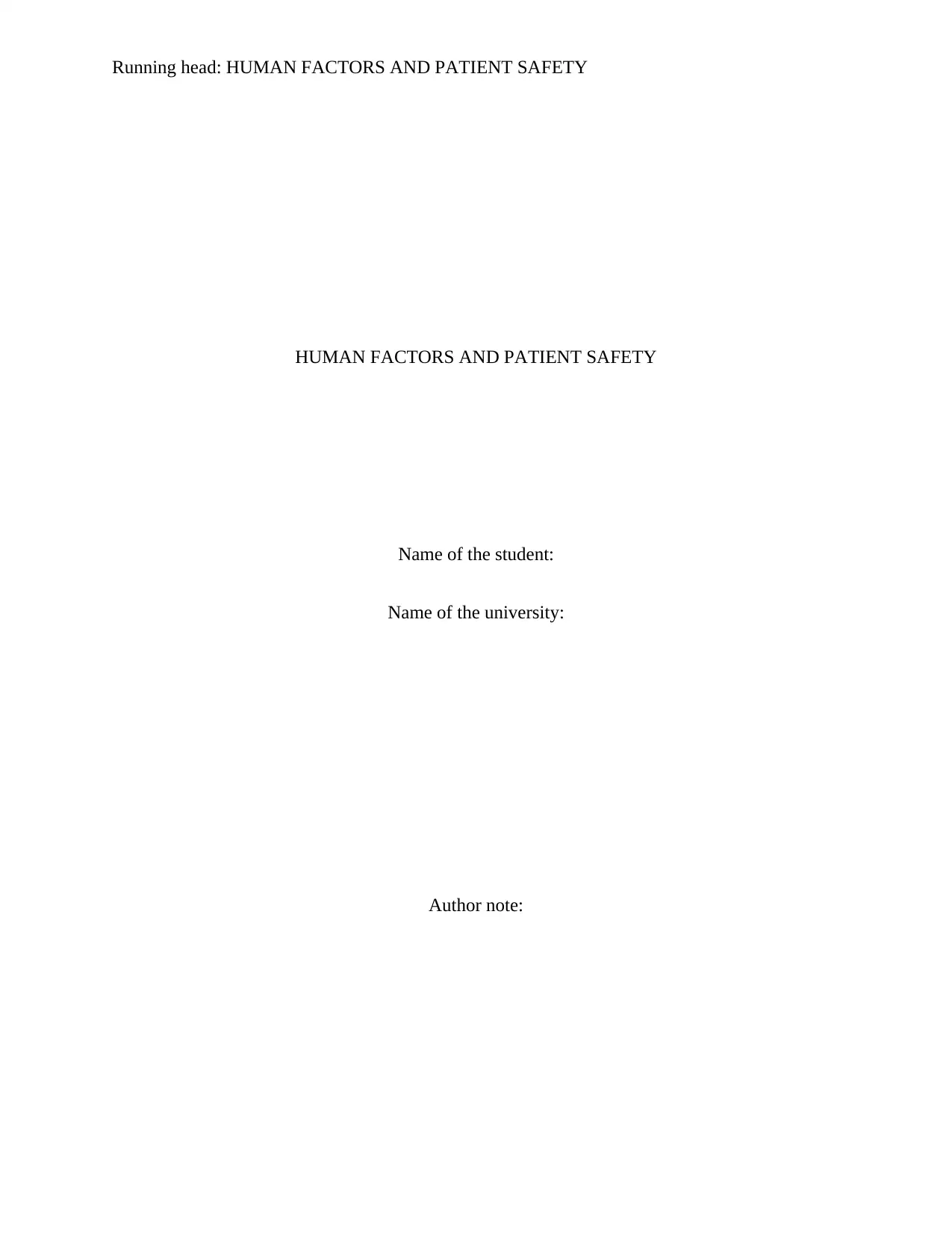
Running head: HUMAN FACTORS AND PATIENT SAFETY
HUMAN FACTORS AND PATIENT SAFETY
Name of the student:
Name of the university:
Author note:
HUMAN FACTORS AND PATIENT SAFETY
Name of the student:
Name of the university:
Author note:
Paraphrase This Document
Need a fresh take? Get an instant paraphrase of this document with our AI Paraphraser
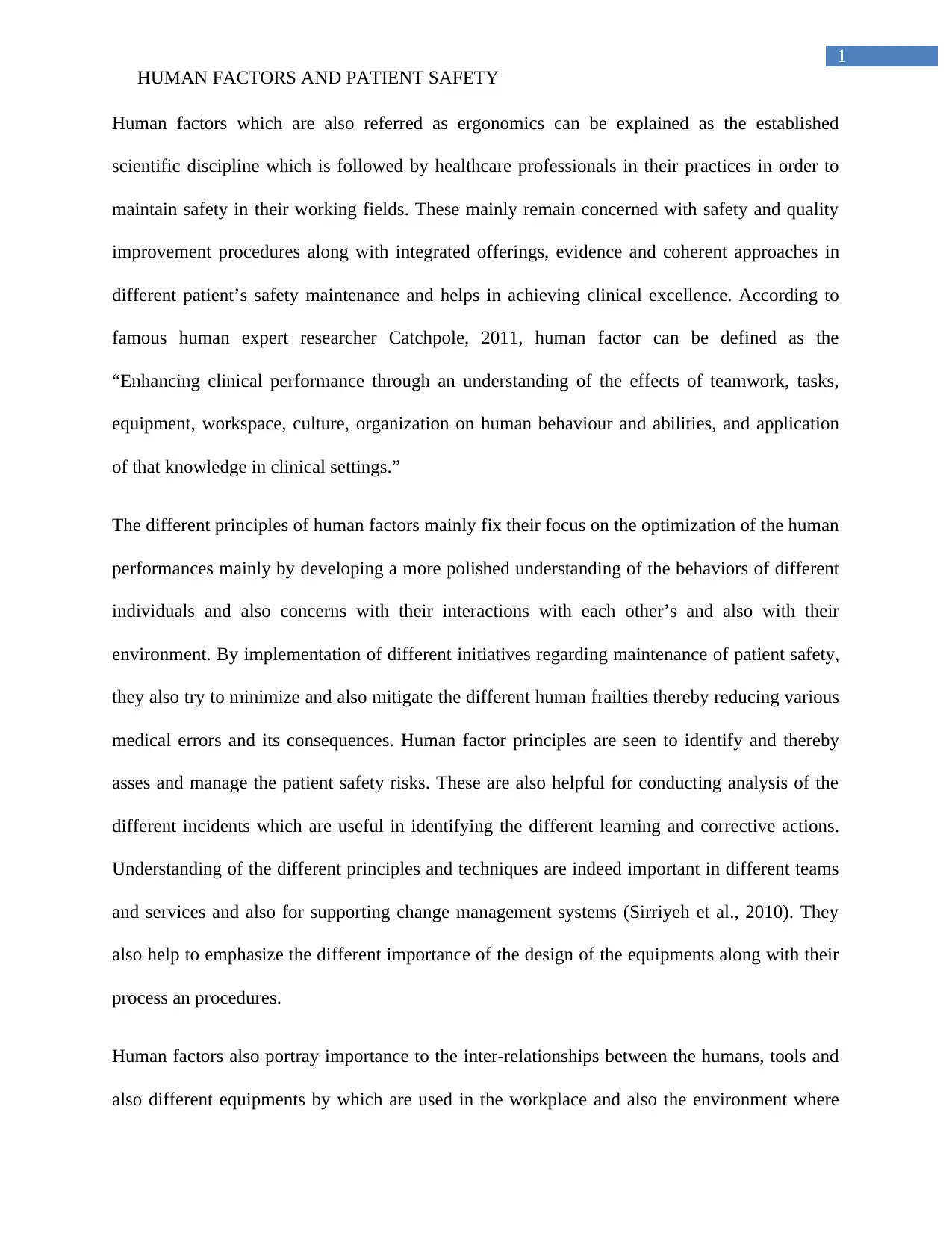
1
HUMAN FACTORS AND PATIENT SAFETY
Human factors which are also referred as ergonomics can be explained as the established
scientific discipline which is followed by healthcare professionals in their practices in order to
maintain safety in their working fields. These mainly remain concerned with safety and quality
improvement procedures along with integrated offerings, evidence and coherent approaches in
different patient’s safety maintenance and helps in achieving clinical excellence. According to
famous human expert researcher Catchpole, 2011, human factor can be defined as the
“Enhancing clinical performance through an understanding of the effects of teamwork, tasks,
equipment, workspace, culture, organization on human behaviour and abilities, and application
of that knowledge in clinical settings.”
The different principles of human factors mainly fix their focus on the optimization of the human
performances mainly by developing a more polished understanding of the behaviors of different
individuals and also concerns with their interactions with each other’s and also with their
environment. By implementation of different initiatives regarding maintenance of patient safety,
they also try to minimize and also mitigate the different human frailties thereby reducing various
medical errors and its consequences. Human factor principles are seen to identify and thereby
asses and manage the patient safety risks. These are also helpful for conducting analysis of the
different incidents which are useful in identifying the different learning and corrective actions.
Understanding of the different principles and techniques are indeed important in different teams
and services and also for supporting change management systems (Sirriyeh et al., 2010). They
also help to emphasize the different importance of the design of the equipments along with their
process an procedures.
Human factors also portray importance to the inter-relationships between the humans, tools and
also different equipments by which are used in the workplace and also the environment where
HUMAN FACTORS AND PATIENT SAFETY
Human factors which are also referred as ergonomics can be explained as the established
scientific discipline which is followed by healthcare professionals in their practices in order to
maintain safety in their working fields. These mainly remain concerned with safety and quality
improvement procedures along with integrated offerings, evidence and coherent approaches in
different patient’s safety maintenance and helps in achieving clinical excellence. According to
famous human expert researcher Catchpole, 2011, human factor can be defined as the
“Enhancing clinical performance through an understanding of the effects of teamwork, tasks,
equipment, workspace, culture, organization on human behaviour and abilities, and application
of that knowledge in clinical settings.”
The different principles of human factors mainly fix their focus on the optimization of the human
performances mainly by developing a more polished understanding of the behaviors of different
individuals and also concerns with their interactions with each other’s and also with their
environment. By implementation of different initiatives regarding maintenance of patient safety,
they also try to minimize and also mitigate the different human frailties thereby reducing various
medical errors and its consequences. Human factor principles are seen to identify and thereby
asses and manage the patient safety risks. These are also helpful for conducting analysis of the
different incidents which are useful in identifying the different learning and corrective actions.
Understanding of the different principles and techniques are indeed important in different teams
and services and also for supporting change management systems (Sirriyeh et al., 2010). They
also help to emphasize the different importance of the design of the equipments along with their
process an procedures.
Human factors also portray importance to the inter-relationships between the humans, tools and
also different equipments by which are used in the workplace and also the environment where
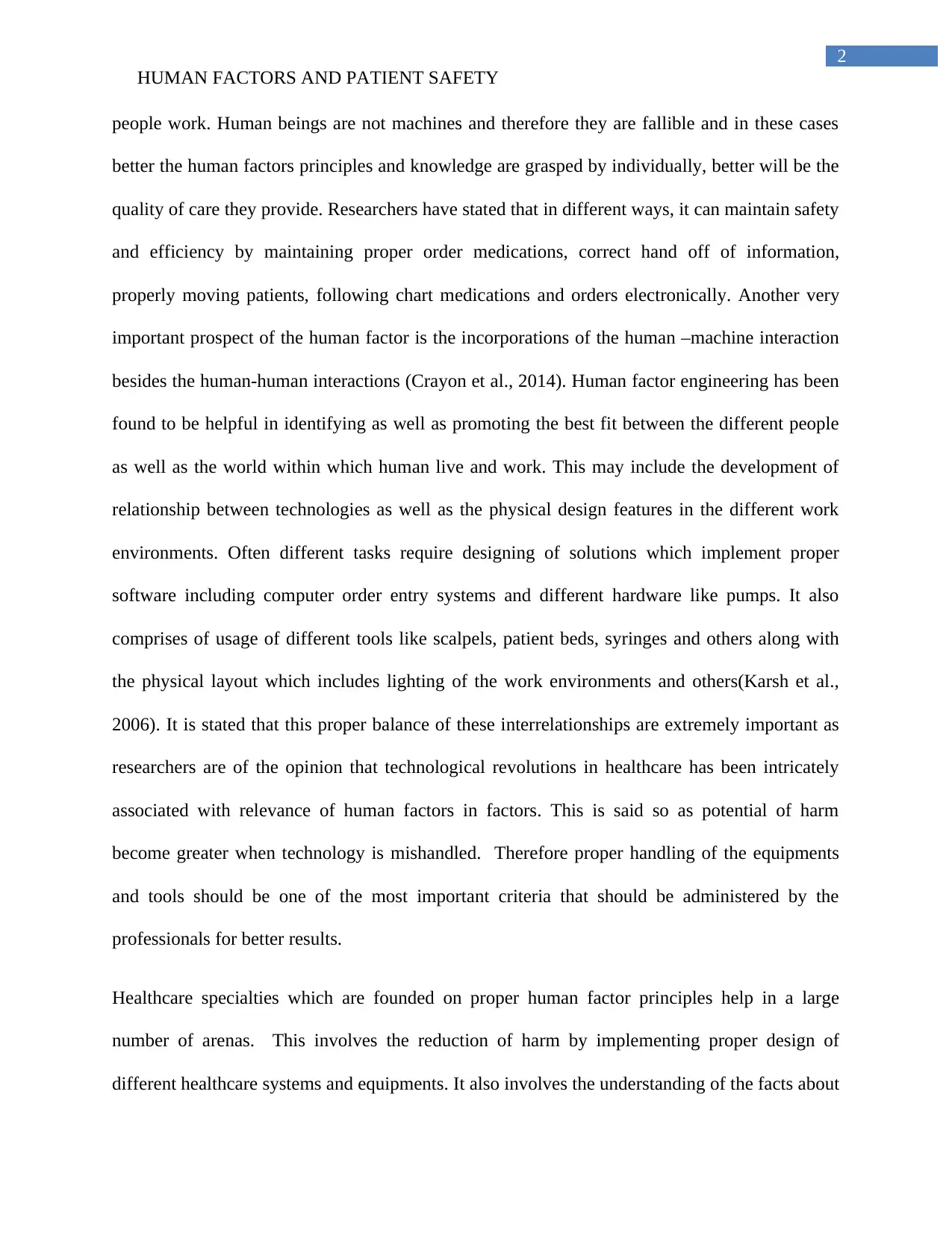
2
HUMAN FACTORS AND PATIENT SAFETY
people work. Human beings are not machines and therefore they are fallible and in these cases
better the human factors principles and knowledge are grasped by individually, better will be the
quality of care they provide. Researchers have stated that in different ways, it can maintain safety
and efficiency by maintaining proper order medications, correct hand off of information,
properly moving patients, following chart medications and orders electronically. Another very
important prospect of the human factor is the incorporations of the human –machine interaction
besides the human-human interactions (Crayon et al., 2014). Human factor engineering has been
found to be helpful in identifying as well as promoting the best fit between the different people
as well as the world within which human live and work. This may include the development of
relationship between technologies as well as the physical design features in the different work
environments. Often different tasks require designing of solutions which implement proper
software including computer order entry systems and different hardware like pumps. It also
comprises of usage of different tools like scalpels, patient beds, syringes and others along with
the physical layout which includes lighting of the work environments and others(Karsh et al.,
2006). It is stated that this proper balance of these interrelationships are extremely important as
researchers are of the opinion that technological revolutions in healthcare has been intricately
associated with relevance of human factors in factors. This is said so as potential of harm
become greater when technology is mishandled. Therefore proper handling of the equipments
and tools should be one of the most important criteria that should be administered by the
professionals for better results.
Healthcare specialties which are founded on proper human factor principles help in a large
number of arenas. This involves the reduction of harm by implementing proper design of
different healthcare systems and equipments. It also involves the understanding of the facts about
HUMAN FACTORS AND PATIENT SAFETY
people work. Human beings are not machines and therefore they are fallible and in these cases
better the human factors principles and knowledge are grasped by individually, better will be the
quality of care they provide. Researchers have stated that in different ways, it can maintain safety
and efficiency by maintaining proper order medications, correct hand off of information,
properly moving patients, following chart medications and orders electronically. Another very
important prospect of the human factor is the incorporations of the human –machine interaction
besides the human-human interactions (Crayon et al., 2014). Human factor engineering has been
found to be helpful in identifying as well as promoting the best fit between the different people
as well as the world within which human live and work. This may include the development of
relationship between technologies as well as the physical design features in the different work
environments. Often different tasks require designing of solutions which implement proper
software including computer order entry systems and different hardware like pumps. It also
comprises of usage of different tools like scalpels, patient beds, syringes and others along with
the physical layout which includes lighting of the work environments and others(Karsh et al.,
2006). It is stated that this proper balance of these interrelationships are extremely important as
researchers are of the opinion that technological revolutions in healthcare has been intricately
associated with relevance of human factors in factors. This is said so as potential of harm
become greater when technology is mishandled. Therefore proper handling of the equipments
and tools should be one of the most important criteria that should be administered by the
professionals for better results.
Healthcare specialties which are founded on proper human factor principles help in a large
number of arenas. This involves the reduction of harm by implementing proper design of
different healthcare systems and equipments. It also involves the understanding of the facts about
⊘ This is a preview!⊘
Do you want full access?
Subscribe today to unlock all pages.

Trusted by 1+ million students worldwide
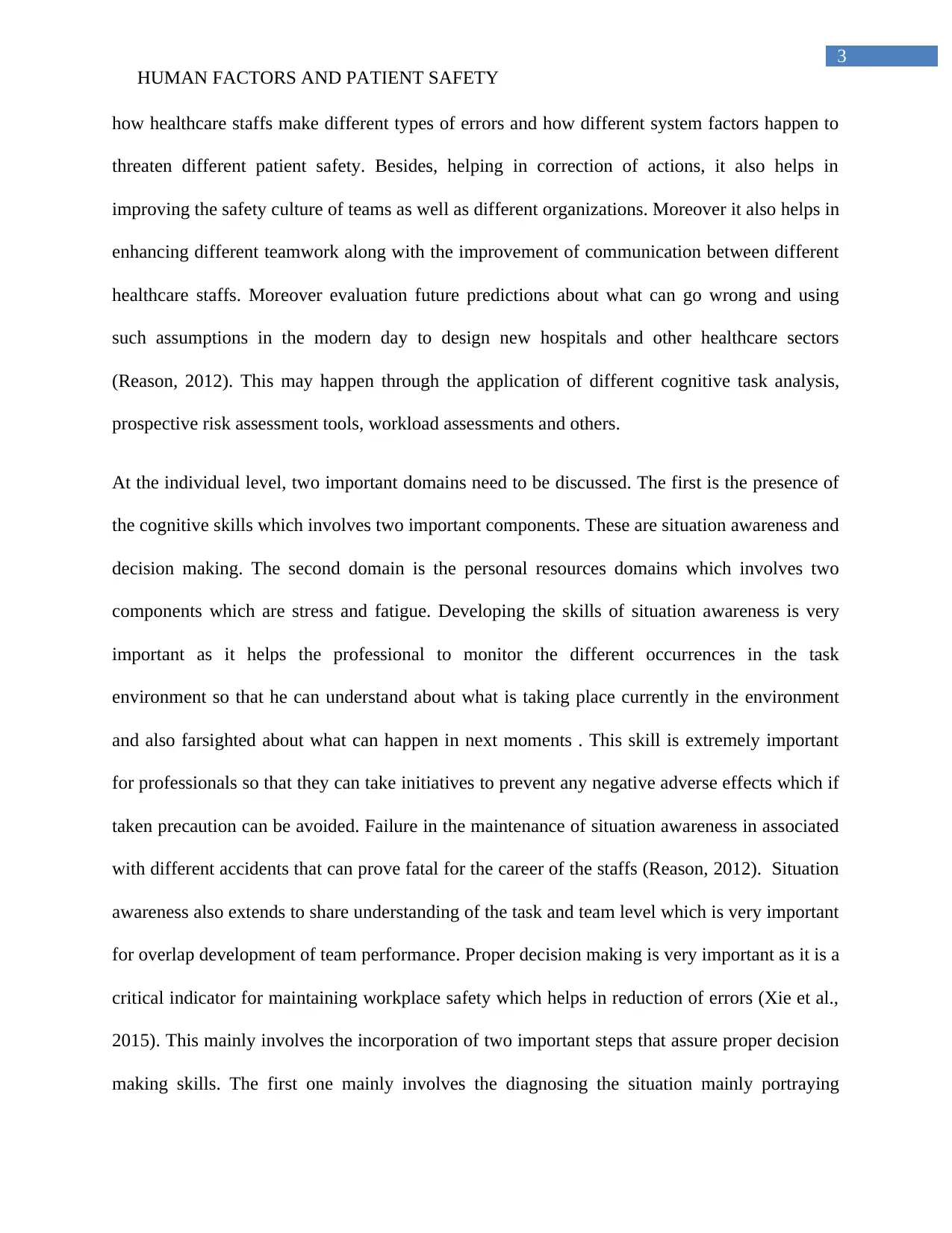
3
HUMAN FACTORS AND PATIENT SAFETY
how healthcare staffs make different types of errors and how different system factors happen to
threaten different patient safety. Besides, helping in correction of actions, it also helps in
improving the safety culture of teams as well as different organizations. Moreover it also helps in
enhancing different teamwork along with the improvement of communication between different
healthcare staffs. Moreover evaluation future predictions about what can go wrong and using
such assumptions in the modern day to design new hospitals and other healthcare sectors
(Reason, 2012). This may happen through the application of different cognitive task analysis,
prospective risk assessment tools, workload assessments and others.
At the individual level, two important domains need to be discussed. The first is the presence of
the cognitive skills which involves two important components. These are situation awareness and
decision making. The second domain is the personal resources domains which involves two
components which are stress and fatigue. Developing the skills of situation awareness is very
important as it helps the professional to monitor the different occurrences in the task
environment so that he can understand about what is taking place currently in the environment
and also farsighted about what can happen in next moments . This skill is extremely important
for professionals so that they can take initiatives to prevent any negative adverse effects which if
taken precaution can be avoided. Failure in the maintenance of situation awareness in associated
with different accidents that can prove fatal for the career of the staffs (Reason, 2012). Situation
awareness also extends to share understanding of the task and team level which is very important
for overlap development of team performance. Proper decision making is very important as it is a
critical indicator for maintaining workplace safety which helps in reduction of errors (Xie et al.,
2015). This mainly involves the incorporation of two important steps that assure proper decision
making skills. The first one mainly involves the diagnosing the situation mainly portraying
HUMAN FACTORS AND PATIENT SAFETY
how healthcare staffs make different types of errors and how different system factors happen to
threaten different patient safety. Besides, helping in correction of actions, it also helps in
improving the safety culture of teams as well as different organizations. Moreover it also helps in
enhancing different teamwork along with the improvement of communication between different
healthcare staffs. Moreover evaluation future predictions about what can go wrong and using
such assumptions in the modern day to design new hospitals and other healthcare sectors
(Reason, 2012). This may happen through the application of different cognitive task analysis,
prospective risk assessment tools, workload assessments and others.
At the individual level, two important domains need to be discussed. The first is the presence of
the cognitive skills which involves two important components. These are situation awareness and
decision making. The second domain is the personal resources domains which involves two
components which are stress and fatigue. Developing the skills of situation awareness is very
important as it helps the professional to monitor the different occurrences in the task
environment so that he can understand about what is taking place currently in the environment
and also farsighted about what can happen in next moments . This skill is extremely important
for professionals so that they can take initiatives to prevent any negative adverse effects which if
taken precaution can be avoided. Failure in the maintenance of situation awareness in associated
with different accidents that can prove fatal for the career of the staffs (Reason, 2012). Situation
awareness also extends to share understanding of the task and team level which is very important
for overlap development of team performance. Proper decision making is very important as it is a
critical indicator for maintaining workplace safety which helps in reduction of errors (Xie et al.,
2015). This mainly involves the incorporation of two important steps that assure proper decision
making skills. The first one mainly involves the diagnosing the situation mainly portraying
Paraphrase This Document
Need a fresh take? Get an instant paraphrase of this document with our AI Paraphraser
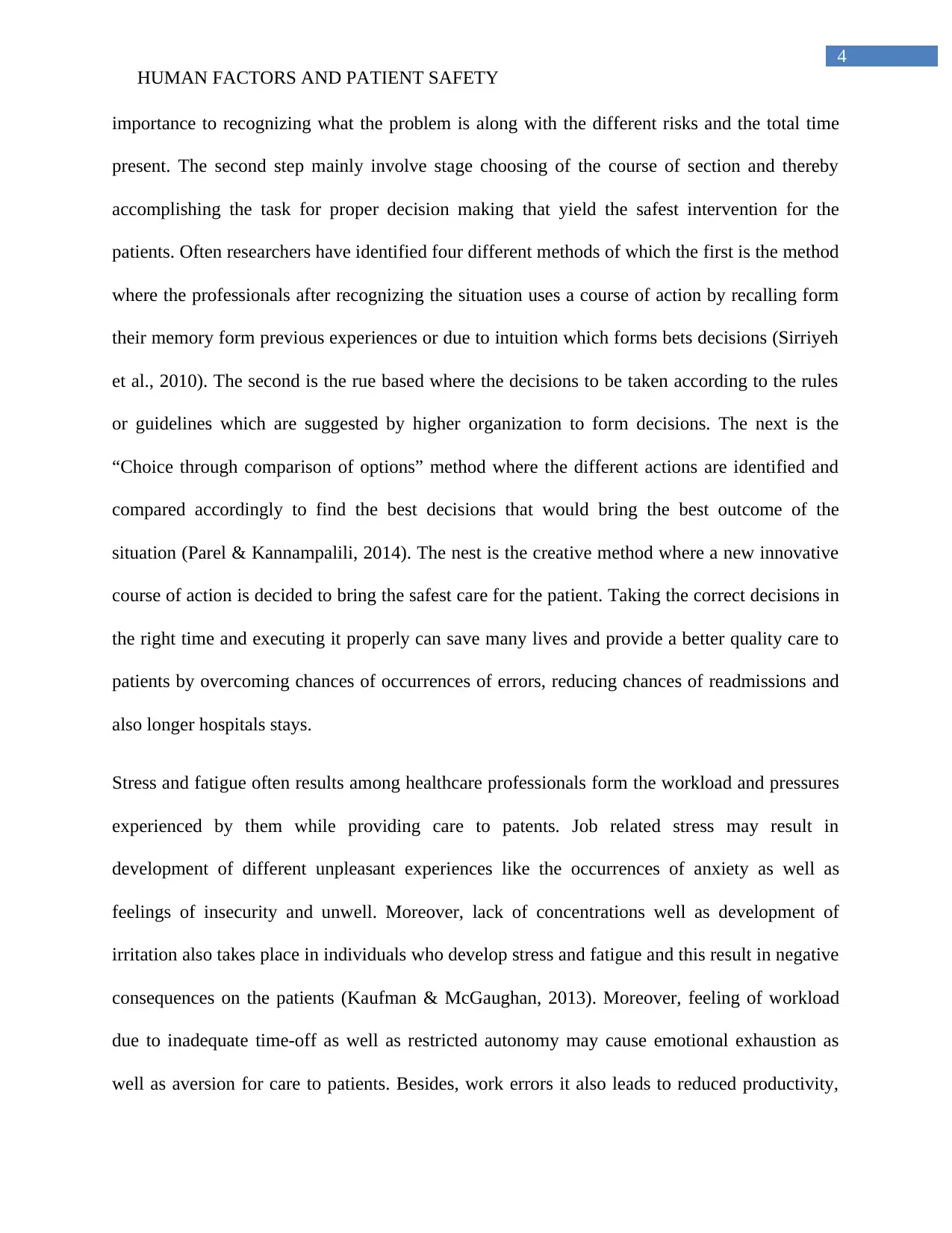
4
HUMAN FACTORS AND PATIENT SAFETY
importance to recognizing what the problem is along with the different risks and the total time
present. The second step mainly involve stage choosing of the course of section and thereby
accomplishing the task for proper decision making that yield the safest intervention for the
patients. Often researchers have identified four different methods of which the first is the method
where the professionals after recognizing the situation uses a course of action by recalling form
their memory form previous experiences or due to intuition which forms bets decisions (Sirriyeh
et al., 2010). The second is the rue based where the decisions to be taken according to the rules
or guidelines which are suggested by higher organization to form decisions. The next is the
“Choice through comparison of options” method where the different actions are identified and
compared accordingly to find the best decisions that would bring the best outcome of the
situation (Parel & Kannampalili, 2014). The nest is the creative method where a new innovative
course of action is decided to bring the safest care for the patient. Taking the correct decisions in
the right time and executing it properly can save many lives and provide a better quality care to
patients by overcoming chances of occurrences of errors, reducing chances of readmissions and
also longer hospitals stays.
Stress and fatigue often results among healthcare professionals form the workload and pressures
experienced by them while providing care to patents. Job related stress may result in
development of different unpleasant experiences like the occurrences of anxiety as well as
feelings of insecurity and unwell. Moreover, lack of concentrations well as development of
irritation also takes place in individuals who develop stress and fatigue and this result in negative
consequences on the patients (Kaufman & McGaughan, 2013). Moreover, feeling of workload
due to inadequate time-off as well as restricted autonomy may cause emotional exhaustion as
well as aversion for care to patients. Besides, work errors it also leads to reduced productivity,
HUMAN FACTORS AND PATIENT SAFETY
importance to recognizing what the problem is along with the different risks and the total time
present. The second step mainly involve stage choosing of the course of section and thereby
accomplishing the task for proper decision making that yield the safest intervention for the
patients. Often researchers have identified four different methods of which the first is the method
where the professionals after recognizing the situation uses a course of action by recalling form
their memory form previous experiences or due to intuition which forms bets decisions (Sirriyeh
et al., 2010). The second is the rue based where the decisions to be taken according to the rules
or guidelines which are suggested by higher organization to form decisions. The next is the
“Choice through comparison of options” method where the different actions are identified and
compared accordingly to find the best decisions that would bring the best outcome of the
situation (Parel & Kannampalili, 2014). The nest is the creative method where a new innovative
course of action is decided to bring the safest care for the patient. Taking the correct decisions in
the right time and executing it properly can save many lives and provide a better quality care to
patients by overcoming chances of occurrences of errors, reducing chances of readmissions and
also longer hospitals stays.
Stress and fatigue often results among healthcare professionals form the workload and pressures
experienced by them while providing care to patents. Job related stress may result in
development of different unpleasant experiences like the occurrences of anxiety as well as
feelings of insecurity and unwell. Moreover, lack of concentrations well as development of
irritation also takes place in individuals who develop stress and fatigue and this result in negative
consequences on the patients (Kaufman & McGaughan, 2013). Moreover, feeling of workload
due to inadequate time-off as well as restricted autonomy may cause emotional exhaustion as
well as aversion for care to patients. Besides, work errors it also leads to reduced productivity,
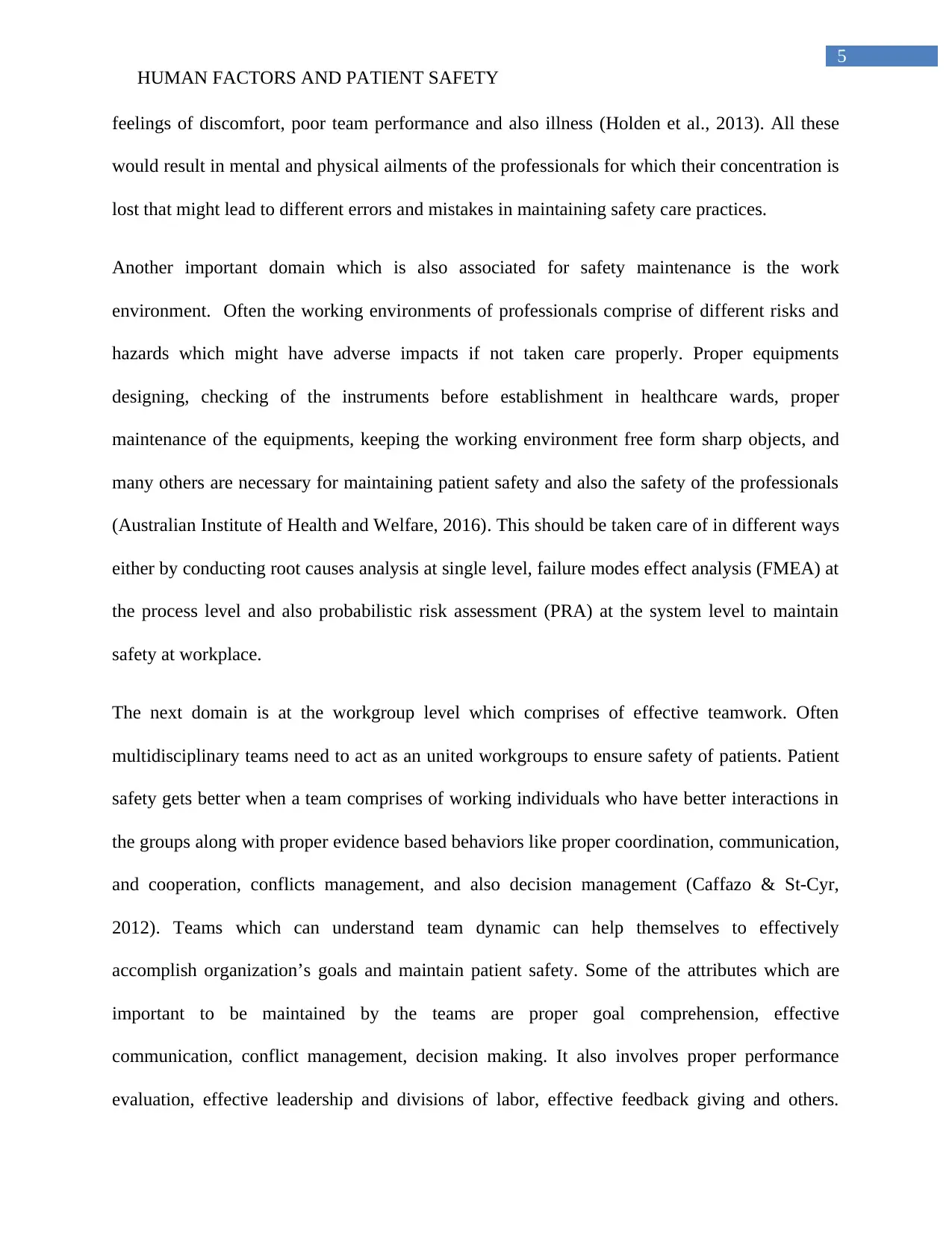
5
HUMAN FACTORS AND PATIENT SAFETY
feelings of discomfort, poor team performance and also illness (Holden et al., 2013). All these
would result in mental and physical ailments of the professionals for which their concentration is
lost that might lead to different errors and mistakes in maintaining safety care practices.
Another important domain which is also associated for safety maintenance is the work
environment. Often the working environments of professionals comprise of different risks and
hazards which might have adverse impacts if not taken care properly. Proper equipments
designing, checking of the instruments before establishment in healthcare wards, proper
maintenance of the equipments, keeping the working environment free form sharp objects, and
many others are necessary for maintaining patient safety and also the safety of the professionals
(Australian Institute of Health and Welfare, 2016). This should be taken care of in different ways
either by conducting root causes analysis at single level, failure modes effect analysis (FMEA) at
the process level and also probabilistic risk assessment (PRA) at the system level to maintain
safety at workplace.
The next domain is at the workgroup level which comprises of effective teamwork. Often
multidisciplinary teams need to act as an united workgroups to ensure safety of patients. Patient
safety gets better when a team comprises of working individuals who have better interactions in
the groups along with proper evidence based behaviors like proper coordination, communication,
and cooperation, conflicts management, and also decision management (Caffazo & St-Cyr,
2012). Teams which can understand team dynamic can help themselves to effectively
accomplish organization’s goals and maintain patient safety. Some of the attributes which are
important to be maintained by the teams are proper goal comprehension, effective
communication, conflict management, decision making. It also involves proper performance
evaluation, effective leadership and divisions of labor, effective feedback giving and others.
HUMAN FACTORS AND PATIENT SAFETY
feelings of discomfort, poor team performance and also illness (Holden et al., 2013). All these
would result in mental and physical ailments of the professionals for which their concentration is
lost that might lead to different errors and mistakes in maintaining safety care practices.
Another important domain which is also associated for safety maintenance is the work
environment. Often the working environments of professionals comprise of different risks and
hazards which might have adverse impacts if not taken care properly. Proper equipments
designing, checking of the instruments before establishment in healthcare wards, proper
maintenance of the equipments, keeping the working environment free form sharp objects, and
many others are necessary for maintaining patient safety and also the safety of the professionals
(Australian Institute of Health and Welfare, 2016). This should be taken care of in different ways
either by conducting root causes analysis at single level, failure modes effect analysis (FMEA) at
the process level and also probabilistic risk assessment (PRA) at the system level to maintain
safety at workplace.
The next domain is at the workgroup level which comprises of effective teamwork. Often
multidisciplinary teams need to act as an united workgroups to ensure safety of patients. Patient
safety gets better when a team comprises of working individuals who have better interactions in
the groups along with proper evidence based behaviors like proper coordination, communication,
and cooperation, conflicts management, and also decision management (Caffazo & St-Cyr,
2012). Teams which can understand team dynamic can help themselves to effectively
accomplish organization’s goals and maintain patient safety. Some of the attributes which are
important to be maintained by the teams are proper goal comprehension, effective
communication, conflict management, decision making. It also involves proper performance
evaluation, effective leadership and divisions of labor, effective feedback giving and others.
⊘ This is a preview!⊘
Do you want full access?
Subscribe today to unlock all pages.

Trusted by 1+ million students worldwide
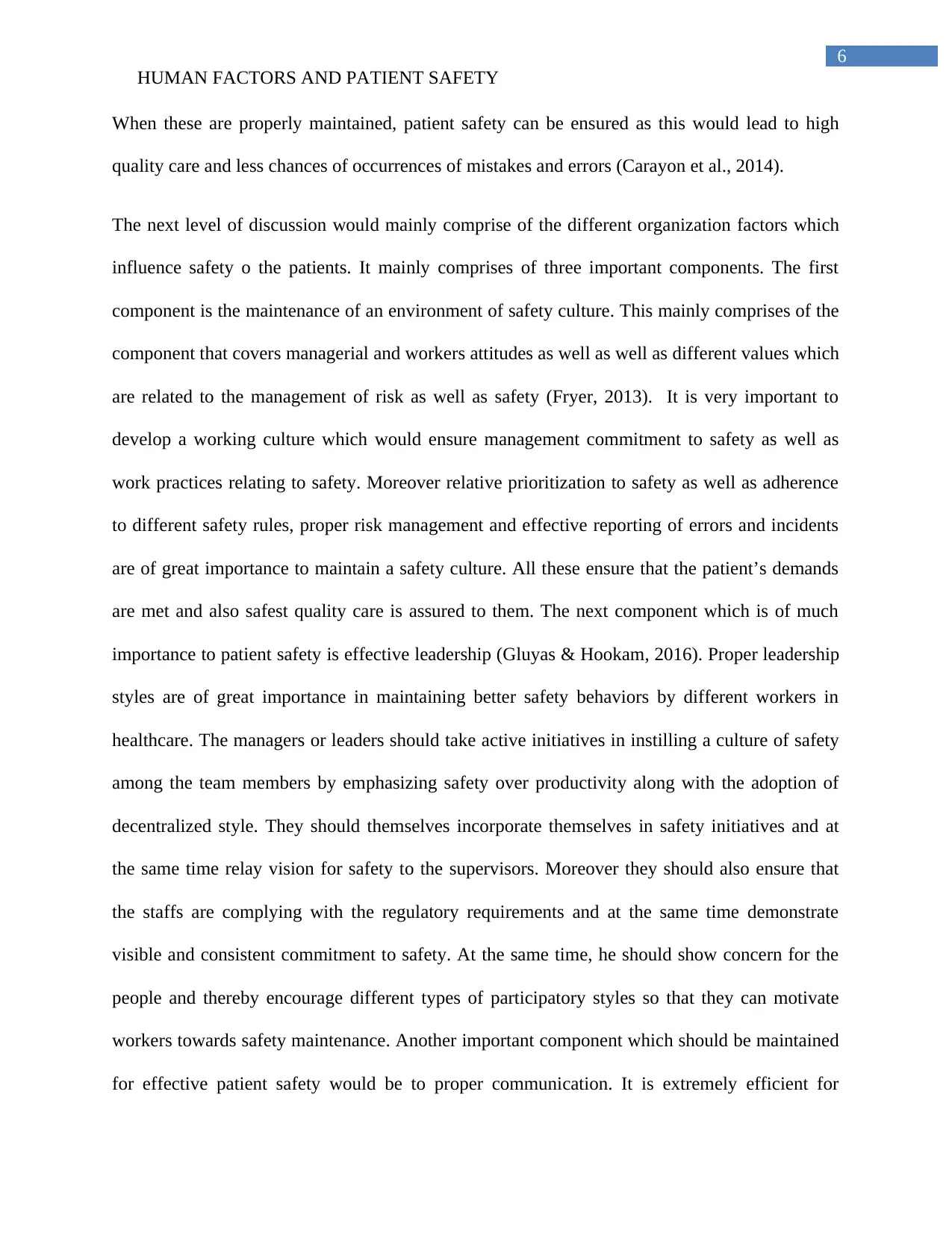
6
HUMAN FACTORS AND PATIENT SAFETY
When these are properly maintained, patient safety can be ensured as this would lead to high
quality care and less chances of occurrences of mistakes and errors (Carayon et al., 2014).
The next level of discussion would mainly comprise of the different organization factors which
influence safety o the patients. It mainly comprises of three important components. The first
component is the maintenance of an environment of safety culture. This mainly comprises of the
component that covers managerial and workers attitudes as well as well as different values which
are related to the management of risk as well as safety (Fryer, 2013). It is very important to
develop a working culture which would ensure management commitment to safety as well as
work practices relating to safety. Moreover relative prioritization to safety as well as adherence
to different safety rules, proper risk management and effective reporting of errors and incidents
are of great importance to maintain a safety culture. All these ensure that the patient’s demands
are met and also safest quality care is assured to them. The next component which is of much
importance to patient safety is effective leadership (Gluyas & Hookam, 2016). Proper leadership
styles are of great importance in maintaining better safety behaviors by different workers in
healthcare. The managers or leaders should take active initiatives in instilling a culture of safety
among the team members by emphasizing safety over productivity along with the adoption of
decentralized style. They should themselves incorporate themselves in safety initiatives and at
the same time relay vision for safety to the supervisors. Moreover they should also ensure that
the staffs are complying with the regulatory requirements and at the same time demonstrate
visible and consistent commitment to safety. At the same time, he should show concern for the
people and thereby encourage different types of participatory styles so that they can motivate
workers towards safety maintenance. Another important component which should be maintained
for effective patient safety would be to proper communication. It is extremely efficient for
HUMAN FACTORS AND PATIENT SAFETY
When these are properly maintained, patient safety can be ensured as this would lead to high
quality care and less chances of occurrences of mistakes and errors (Carayon et al., 2014).
The next level of discussion would mainly comprise of the different organization factors which
influence safety o the patients. It mainly comprises of three important components. The first
component is the maintenance of an environment of safety culture. This mainly comprises of the
component that covers managerial and workers attitudes as well as well as different values which
are related to the management of risk as well as safety (Fryer, 2013). It is very important to
develop a working culture which would ensure management commitment to safety as well as
work practices relating to safety. Moreover relative prioritization to safety as well as adherence
to different safety rules, proper risk management and effective reporting of errors and incidents
are of great importance to maintain a safety culture. All these ensure that the patient’s demands
are met and also safest quality care is assured to them. The next component which is of much
importance to patient safety is effective leadership (Gluyas & Hookam, 2016). Proper leadership
styles are of great importance in maintaining better safety behaviors by different workers in
healthcare. The managers or leaders should take active initiatives in instilling a culture of safety
among the team members by emphasizing safety over productivity along with the adoption of
decentralized style. They should themselves incorporate themselves in safety initiatives and at
the same time relay vision for safety to the supervisors. Moreover they should also ensure that
the staffs are complying with the regulatory requirements and at the same time demonstrate
visible and consistent commitment to safety. At the same time, he should show concern for the
people and thereby encourage different types of participatory styles so that they can motivate
workers towards safety maintenance. Another important component which should be maintained
for effective patient safety would be to proper communication. It is extremely efficient for
Paraphrase This Document
Need a fresh take? Get an instant paraphrase of this document with our AI Paraphraser
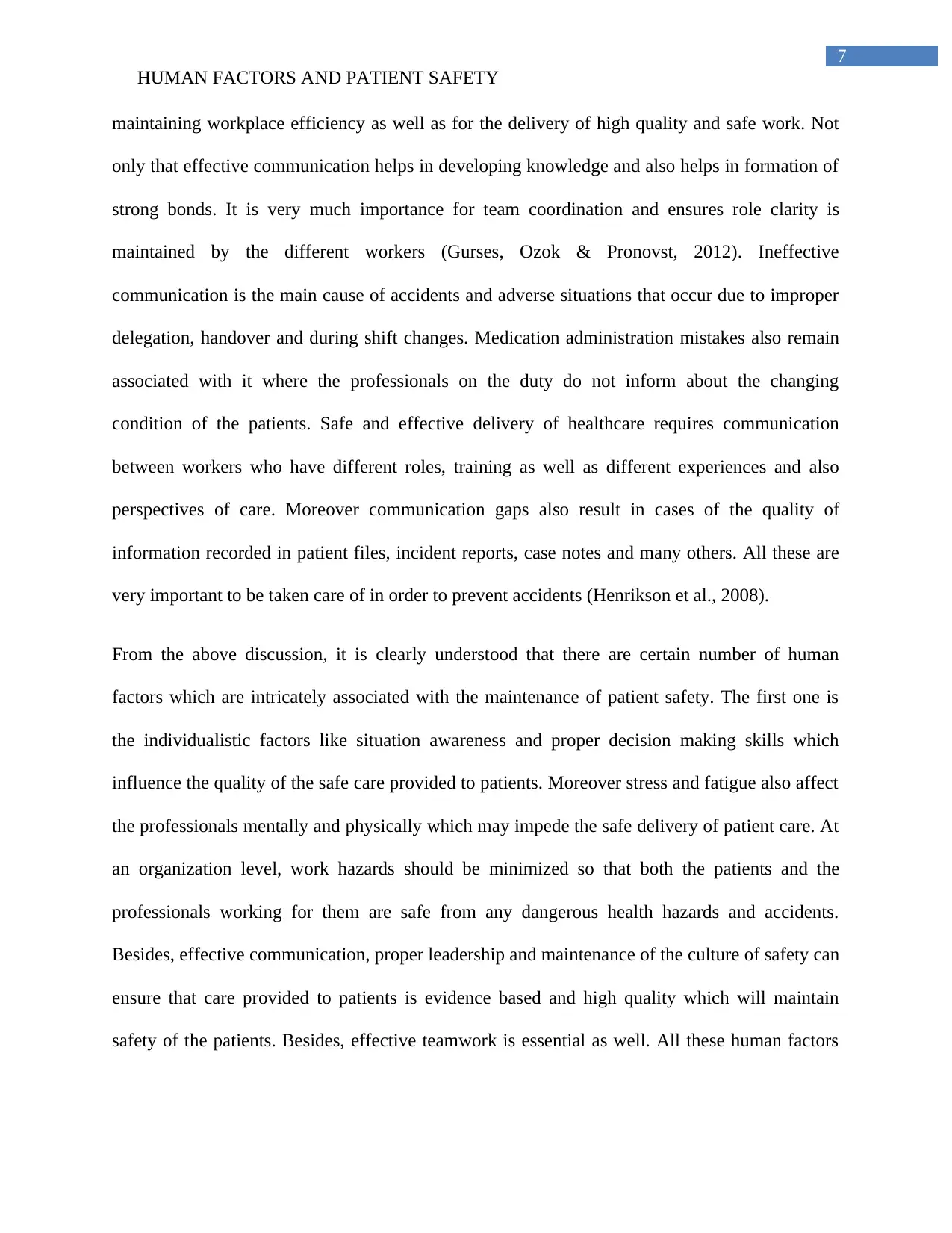
7
HUMAN FACTORS AND PATIENT SAFETY
maintaining workplace efficiency as well as for the delivery of high quality and safe work. Not
only that effective communication helps in developing knowledge and also helps in formation of
strong bonds. It is very much importance for team coordination and ensures role clarity is
maintained by the different workers (Gurses, Ozok & Pronovst, 2012). Ineffective
communication is the main cause of accidents and adverse situations that occur due to improper
delegation, handover and during shift changes. Medication administration mistakes also remain
associated with it where the professionals on the duty do not inform about the changing
condition of the patients. Safe and effective delivery of healthcare requires communication
between workers who have different roles, training as well as different experiences and also
perspectives of care. Moreover communication gaps also result in cases of the quality of
information recorded in patient files, incident reports, case notes and many others. All these are
very important to be taken care of in order to prevent accidents (Henrikson et al., 2008).
From the above discussion, it is clearly understood that there are certain number of human
factors which are intricately associated with the maintenance of patient safety. The first one is
the individualistic factors like situation awareness and proper decision making skills which
influence the quality of the safe care provided to patients. Moreover stress and fatigue also affect
the professionals mentally and physically which may impede the safe delivery of patient care. At
an organization level, work hazards should be minimized so that both the patients and the
professionals working for them are safe from any dangerous health hazards and accidents.
Besides, effective communication, proper leadership and maintenance of the culture of safety can
ensure that care provided to patients is evidence based and high quality which will maintain
safety of the patients. Besides, effective teamwork is essential as well. All these human factors
HUMAN FACTORS AND PATIENT SAFETY
maintaining workplace efficiency as well as for the delivery of high quality and safe work. Not
only that effective communication helps in developing knowledge and also helps in formation of
strong bonds. It is very much importance for team coordination and ensures role clarity is
maintained by the different workers (Gurses, Ozok & Pronovst, 2012). Ineffective
communication is the main cause of accidents and adverse situations that occur due to improper
delegation, handover and during shift changes. Medication administration mistakes also remain
associated with it where the professionals on the duty do not inform about the changing
condition of the patients. Safe and effective delivery of healthcare requires communication
between workers who have different roles, training as well as different experiences and also
perspectives of care. Moreover communication gaps also result in cases of the quality of
information recorded in patient files, incident reports, case notes and many others. All these are
very important to be taken care of in order to prevent accidents (Henrikson et al., 2008).
From the above discussion, it is clearly understood that there are certain number of human
factors which are intricately associated with the maintenance of patient safety. The first one is
the individualistic factors like situation awareness and proper decision making skills which
influence the quality of the safe care provided to patients. Moreover stress and fatigue also affect
the professionals mentally and physically which may impede the safe delivery of patient care. At
an organization level, work hazards should be minimized so that both the patients and the
professionals working for them are safe from any dangerous health hazards and accidents.
Besides, effective communication, proper leadership and maintenance of the culture of safety can
ensure that care provided to patients is evidence based and high quality which will maintain
safety of the patients. Besides, effective teamwork is essential as well. All these human factors
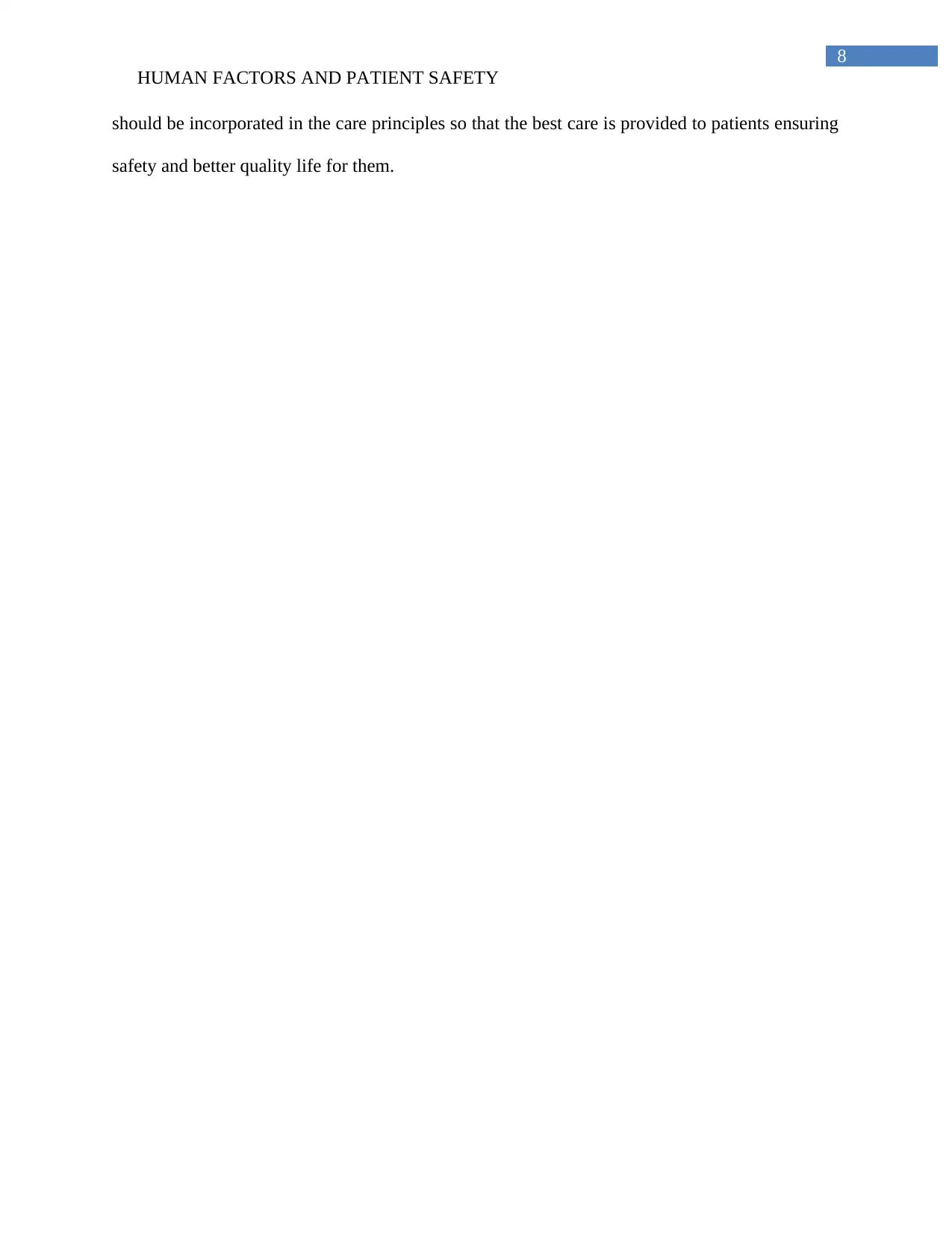
8
HUMAN FACTORS AND PATIENT SAFETY
should be incorporated in the care principles so that the best care is provided to patients ensuring
safety and better quality life for them.
HUMAN FACTORS AND PATIENT SAFETY
should be incorporated in the care principles so that the best care is provided to patients ensuring
safety and better quality life for them.
⊘ This is a preview!⊘
Do you want full access?
Subscribe today to unlock all pages.

Trusted by 1+ million students worldwide
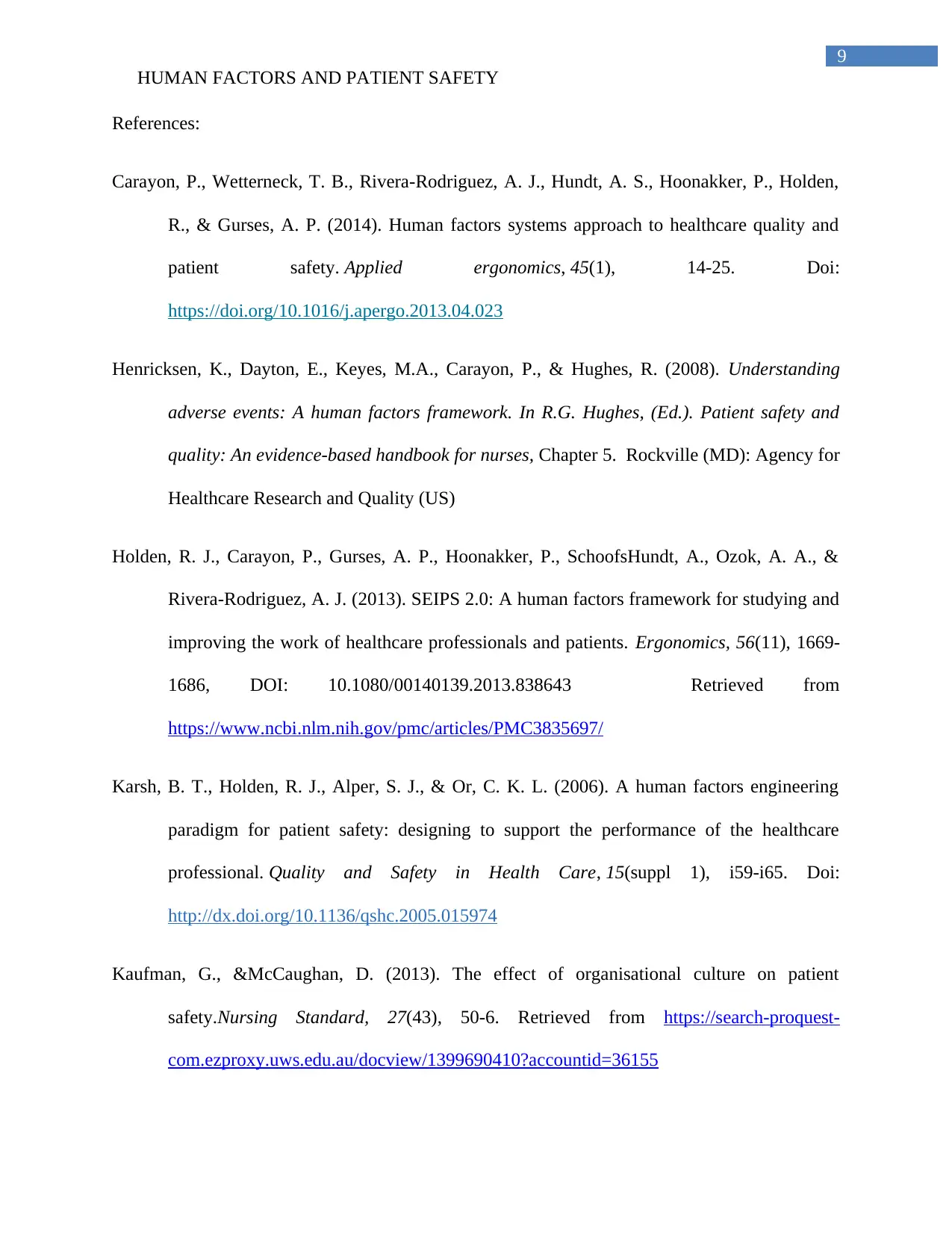
9
HUMAN FACTORS AND PATIENT SAFETY
References:
Carayon, P., Wetterneck, T. B., Rivera-Rodriguez, A. J., Hundt, A. S., Hoonakker, P., Holden,
R., & Gurses, A. P. (2014). Human factors systems approach to healthcare quality and
patient safety. Applied ergonomics, 45(1), 14-25. Doi:
https://doi.org/10.1016/j.apergo.2013.04.023
Henricksen, K., Dayton, E., Keyes, M.A., Carayon, P., & Hughes, R. (2008). Understanding
adverse events: A human factors framework. In R.G. Hughes, (Ed.). Patient safety and
quality: An evidence-based handbook for nurses, Chapter 5. Rockville (MD): Agency for
Healthcare Research and Quality (US)
Holden, R. J., Carayon, P., Gurses, A. P., Hoonakker, P., SchoofsHundt, A., Ozok, A. A., &
Rivera-Rodriguez, A. J. (2013). SEIPS 2.0: A human factors framework for studying and
improving the work of healthcare professionals and patients. Ergonomics, 56(11), 1669-
1686, DOI: 10.1080/00140139.2013.838643 Retrieved from
https://www.ncbi.nlm.nih.gov/pmc/articles/PMC3835697/
Karsh, B. T., Holden, R. J., Alper, S. J., & Or, C. K. L. (2006). A human factors engineering
paradigm for patient safety: designing to support the performance of the healthcare
professional. Quality and Safety in Health Care, 15(suppl 1), i59-i65. Doi:
http://dx.doi.org/10.1136/qshc.2005.015974
Kaufman, G., &McCaughan, D. (2013). The effect of organisational culture on patient
safety.Nursing Standard, 27(43), 50-6. Retrieved from https://search-proquest-
com.ezproxy.uws.edu.au/docview/1399690410?accountid=36155
HUMAN FACTORS AND PATIENT SAFETY
References:
Carayon, P., Wetterneck, T. B., Rivera-Rodriguez, A. J., Hundt, A. S., Hoonakker, P., Holden,
R., & Gurses, A. P. (2014). Human factors systems approach to healthcare quality and
patient safety. Applied ergonomics, 45(1), 14-25. Doi:
https://doi.org/10.1016/j.apergo.2013.04.023
Henricksen, K., Dayton, E., Keyes, M.A., Carayon, P., & Hughes, R. (2008). Understanding
adverse events: A human factors framework. In R.G. Hughes, (Ed.). Patient safety and
quality: An evidence-based handbook for nurses, Chapter 5. Rockville (MD): Agency for
Healthcare Research and Quality (US)
Holden, R. J., Carayon, P., Gurses, A. P., Hoonakker, P., SchoofsHundt, A., Ozok, A. A., &
Rivera-Rodriguez, A. J. (2013). SEIPS 2.0: A human factors framework for studying and
improving the work of healthcare professionals and patients. Ergonomics, 56(11), 1669-
1686, DOI: 10.1080/00140139.2013.838643 Retrieved from
https://www.ncbi.nlm.nih.gov/pmc/articles/PMC3835697/
Karsh, B. T., Holden, R. J., Alper, S. J., & Or, C. K. L. (2006). A human factors engineering
paradigm for patient safety: designing to support the performance of the healthcare
professional. Quality and Safety in Health Care, 15(suppl 1), i59-i65. Doi:
http://dx.doi.org/10.1136/qshc.2005.015974
Kaufman, G., &McCaughan, D. (2013). The effect of organisational culture on patient
safety.Nursing Standard, 27(43), 50-6. Retrieved from https://search-proquest-
com.ezproxy.uws.edu.au/docview/1399690410?accountid=36155
Paraphrase This Document
Need a fresh take? Get an instant paraphrase of this document with our AI Paraphraser
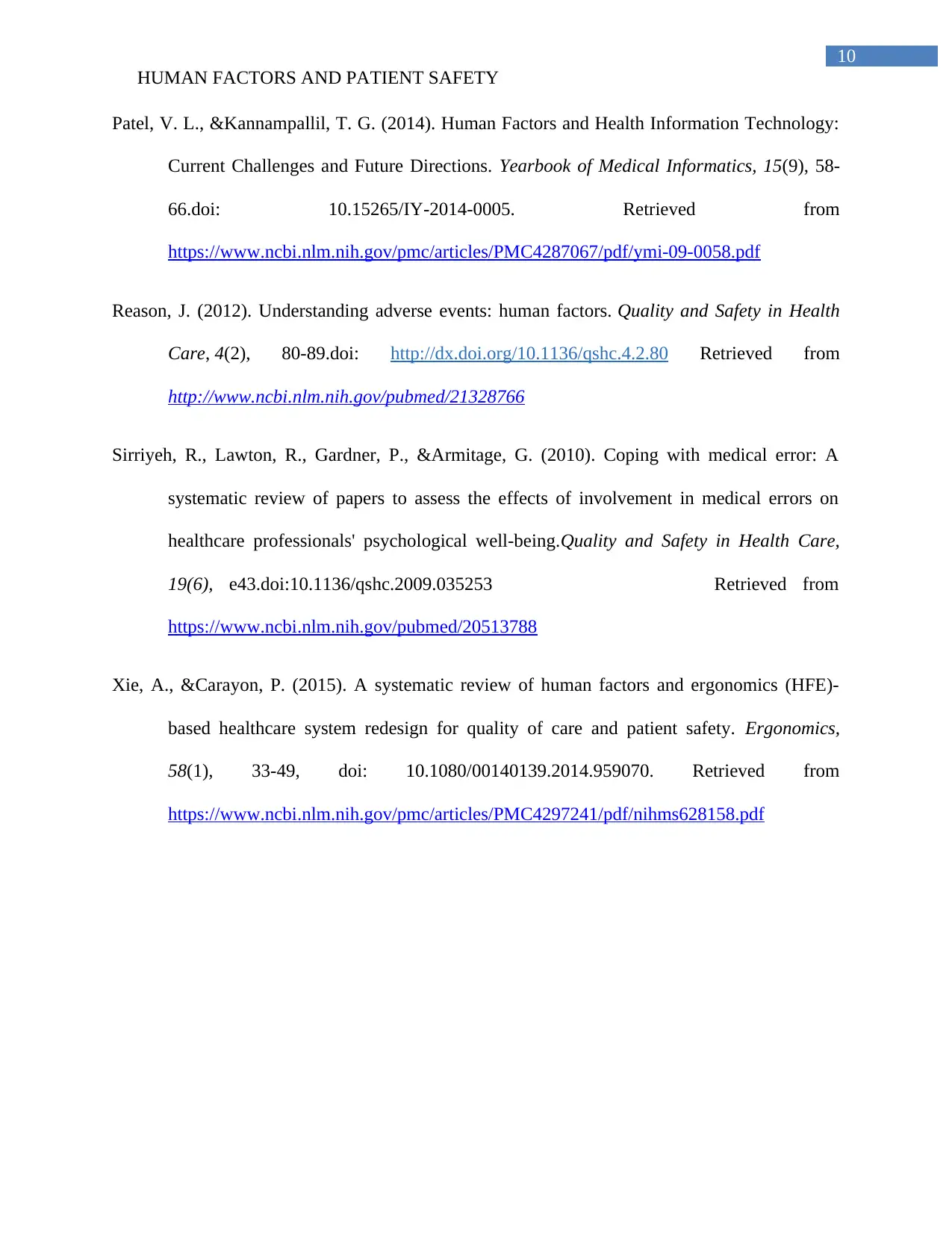
10
HUMAN FACTORS AND PATIENT SAFETY
Patel, V. L., &Kannampallil, T. G. (2014). Human Factors and Health Information Technology:
Current Challenges and Future Directions. Yearbook of Medical Informatics, 15(9), 58-
66.doi: 10.15265/IY-2014-0005. Retrieved from
https://www.ncbi.nlm.nih.gov/pmc/articles/PMC4287067/pdf/ymi-09-0058.pdf
Reason, J. (2012). Understanding adverse events: human factors. Quality and Safety in Health
Care, 4(2), 80-89.doi: http://dx.doi.org/10.1136/qshc.4.2.80 Retrieved from
http://www.ncbi.nlm.nih.gov/pubmed/21328766
Sirriyeh, R., Lawton, R., Gardner, P., &Armitage, G. (2010). Coping with medical error: A
systematic review of papers to assess the effects of involvement in medical errors on
healthcare professionals' psychological well-being.Quality and Safety in Health Care,
19(6), e43.doi:10.1136/qshc.2009.035253 Retrieved from
https://www.ncbi.nlm.nih.gov/pubmed/20513788
Xie, A., &Carayon, P. (2015). A systematic review of human factors and ergonomics (HFE)-
based healthcare system redesign for quality of care and patient safety. Ergonomics,
58(1), 33-49, doi: 10.1080/00140139.2014.959070. Retrieved from
https://www.ncbi.nlm.nih.gov/pmc/articles/PMC4297241/pdf/nihms628158.pdf
HUMAN FACTORS AND PATIENT SAFETY
Patel, V. L., &Kannampallil, T. G. (2014). Human Factors and Health Information Technology:
Current Challenges and Future Directions. Yearbook of Medical Informatics, 15(9), 58-
66.doi: 10.15265/IY-2014-0005. Retrieved from
https://www.ncbi.nlm.nih.gov/pmc/articles/PMC4287067/pdf/ymi-09-0058.pdf
Reason, J. (2012). Understanding adverse events: human factors. Quality and Safety in Health
Care, 4(2), 80-89.doi: http://dx.doi.org/10.1136/qshc.4.2.80 Retrieved from
http://www.ncbi.nlm.nih.gov/pubmed/21328766
Sirriyeh, R., Lawton, R., Gardner, P., &Armitage, G. (2010). Coping with medical error: A
systematic review of papers to assess the effects of involvement in medical errors on
healthcare professionals' psychological well-being.Quality and Safety in Health Care,
19(6), e43.doi:10.1136/qshc.2009.035253 Retrieved from
https://www.ncbi.nlm.nih.gov/pubmed/20513788
Xie, A., &Carayon, P. (2015). A systematic review of human factors and ergonomics (HFE)-
based healthcare system redesign for quality of care and patient safety. Ergonomics,
58(1), 33-49, doi: 10.1080/00140139.2014.959070. Retrieved from
https://www.ncbi.nlm.nih.gov/pmc/articles/PMC4297241/pdf/nihms628158.pdf
1 out of 11
Related Documents
Your All-in-One AI-Powered Toolkit for Academic Success.
+13062052269
info@desklib.com
Available 24*7 on WhatsApp / Email
![[object Object]](/_next/static/media/star-bottom.7253800d.svg)
Unlock your academic potential
Copyright © 2020–2025 A2Z Services. All Rights Reserved. Developed and managed by ZUCOL.





